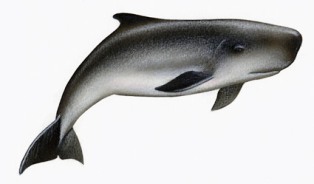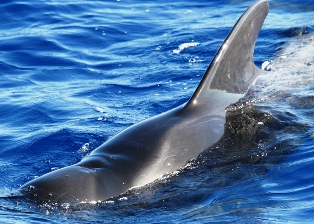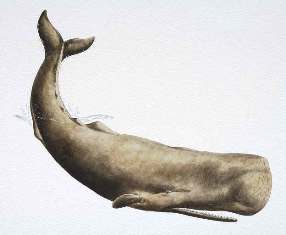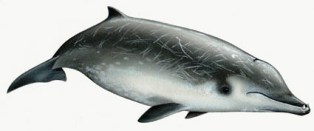Discover Florida Nature
It's time to explore the natural Florida


|
|
|
|
|
 Pygmy
Sperm Whale- The dwarf and pygmy sperm whales are the only two
extant species in the family Kogiidae, and as their name suggests
they are small compared to their distant cousin the sperm whale. Like
sperm whales, their mouth is on the underside of their body, but unlike
sperm whales they have very few and very small teeth that are sharply
pointed and curved. Like sperm whales, they are suction feeders and eat
mostly octopus and squid, but it also eats crab, fish, and shrimp.
The forward part of the body of the pygmy sperm whale is stocky, but it
rapidly becomes more tapered and narrow behind the dorsal fin. Its head
is squared with a small, underslung lower jaw containing 12-16 sharply
curved pairs of teeth. The
pygmy sperm whale's body is blue-gray to black above, shading to light
gray on the sides and soft white to pink on the belly,. with an average
length of 10 feet for both sexes. The maximum weight of a pygmy sperm
whale is 900 pounds.
Pygmy sperm whales may be found in all temperate, sub-tropical, and
tropical waters. As far as we know they don't migrate. Pygmy
Sperm Whale- The dwarf and pygmy sperm whales are the only two
extant species in the family Kogiidae, and as their name suggests
they are small compared to their distant cousin the sperm whale. Like
sperm whales, their mouth is on the underside of their body, but unlike
sperm whales they have very few and very small teeth that are sharply
pointed and curved. Like sperm whales, they are suction feeders and eat
mostly octopus and squid, but it also eats crab, fish, and shrimp.
The forward part of the body of the pygmy sperm whale is stocky, but it
rapidly becomes more tapered and narrow behind the dorsal fin. Its head
is squared with a small, underslung lower jaw containing 12-16 sharply
curved pairs of teeth. The
pygmy sperm whale's body is blue-gray to black above, shading to light
gray on the sides and soft white to pink on the belly,. with an average
length of 10 feet for both sexes. The maximum weight of a pygmy sperm
whale is 900 pounds.
Pygmy sperm whales may be found in all temperate, sub-tropical, and
tropical waters. As far as we know they don't migrate. Short-finned
Pilot Whale-
The Short-finned pilot Whale is a common inhabitants of offshore
tropical, subtropical, and warm temperate waters of the world. They are
common in the Gulf of Mexico and numerous stranding and sighting records
are available from Florida. Short-finned pilot whales may congregate in
large numbers offshore — schools of several hundred have been observed —
but group size usually ranges from 10 to 60. They are seen inshore at
infrequent intervals and occasionally become stranded by severe storms.
In fact, these are among the most frequently stranded of cetaceans, and
often mass strand. These dolphins have mass stranded 15 times in the
Gulf of Mexico, although none of these events occurred in Texas. Pilot
whales are highly communicative and make a variety of sounds, including
noises described as "squealing, whistling, loud smacking, whining, and
snores." They probably are excellent echolocators. The food habits of
pilot whales are not well known. In the wild they feed on squid and
fish; a captive whale consumed 20 kg of squid per day. The body in pilot
whales is robust, with a thick tail stock. The melon is exaggerated and
bulbous and the beak is barely discernible or non-existent. Adults reach
a body length of approx. 20 feet, males being larger than females. Short-finned
Pilot Whale-
The Short-finned pilot Whale is a common inhabitants of offshore
tropical, subtropical, and warm temperate waters of the world. They are
common in the Gulf of Mexico and numerous stranding and sighting records
are available from Florida. Short-finned pilot whales may congregate in
large numbers offshore — schools of several hundred have been observed —
but group size usually ranges from 10 to 60. They are seen inshore at
infrequent intervals and occasionally become stranded by severe storms.
In fact, these are among the most frequently stranded of cetaceans, and
often mass strand. These dolphins have mass stranded 15 times in the
Gulf of Mexico, although none of these events occurred in Texas. Pilot
whales are highly communicative and make a variety of sounds, including
noises described as "squealing, whistling, loud smacking, whining, and
snores." They probably are excellent echolocators. The food habits of
pilot whales are not well known. In the wild they feed on squid and
fish; a captive whale consumed 20 kg of squid per day. The body in pilot
whales is robust, with a thick tail stock. The melon is exaggerated and
bulbous and the beak is barely discernible or non-existent. Adults reach
a body length of approx. 20 feet, males being larger than females. Sperm
Whale- The sperm whale is a toothed whale that lives in pods.
It has a huge brain that weighs about 20 pounds, the largest brain of
any animal. The sperm whale has a single blowhole that is s-shaped and
about 20 inches long. The blowhole is located on the left side of the
front if its huge head. The sperm whale has a 4-12 inch thick layer of
blubber. Sperm whales produce ambergris, a dark, waxy substance (related
to cholesterol) that is produced in the lower intestines, and is
sometimes found containing squid beaks. Ambergris may help protect the
sperm whale from the stings on the giant squid, its major food. Large
lumps of ambergris may be vomited up by the sperm whale. The fictional
Moby Dick was a sperm whale. Sperm whales are the largest toothed
whales. Adult males grow to be about 50-60 feet long, weighing about
40-50 tons. Females are smaller, about 33-40 feet long, weighing about
14-18 tons. The skin of the sperm whale is usually dark gray to black,
but is occasionally light gray. It has a distinctive, prune-like
texture. Sperm whales are the deepest diving whales. Although they live
at the surface they dive to hunt giant squid that are bottom dwellers.
Able to hold it's breath for up to an hour, the sperm whale's average
dives are about 4,000 feet deep. Sperm whales are found in many open
oceans, both in tropical and cool waters. The sperm whale is listed as
an
endangered species in Florida Sperm
Whale- The sperm whale is a toothed whale that lives in pods.
It has a huge brain that weighs about 20 pounds, the largest brain of
any animal. The sperm whale has a single blowhole that is s-shaped and
about 20 inches long. The blowhole is located on the left side of the
front if its huge head. The sperm whale has a 4-12 inch thick layer of
blubber. Sperm whales produce ambergris, a dark, waxy substance (related
to cholesterol) that is produced in the lower intestines, and is
sometimes found containing squid beaks. Ambergris may help protect the
sperm whale from the stings on the giant squid, its major food. Large
lumps of ambergris may be vomited up by the sperm whale. The fictional
Moby Dick was a sperm whale. Sperm whales are the largest toothed
whales. Adult males grow to be about 50-60 feet long, weighing about
40-50 tons. Females are smaller, about 33-40 feet long, weighing about
14-18 tons. The skin of the sperm whale is usually dark gray to black,
but is occasionally light gray. It has a distinctive, prune-like
texture. Sperm whales are the deepest diving whales. Although they live
at the surface they dive to hunt giant squid that are bottom dwellers.
Able to hold it's breath for up to an hour, the sperm whale's average
dives are about 4,000 feet deep. Sperm whales are found in many open
oceans, both in tropical and cool waters. The sperm whale is listed as
an
endangered species in Florida True's
Beaked Whale- True's beaked whale is found in the North
Atlantic from Nova Scotia and Ireland south to Florida. True's Beaked
Whales from the Northern Hemisphere are grey fading to light grey on the
undersides. Adults have a dark ring around the eye and some areas of
white. Southern Hemisphere adults have a white area trailing backwards
from the dorsal fin, a darker, flecked belly, and the tip of the beak
becomes white. Scratches and scars appear on all animals, and a small
tooth is exposed either side of the lower jaw in males. The largest
female documented measured 19 feet and weighed 3,080 pounds! They have a
single nostril or blowhole. Beaked whales are generally slender with a
small dorsal fin placed towards the rear on the back. The rear edge of
the flukes usually lacks a well-defined notch. These whales are deep
divers and are rarely seen. Many species are known only from a few
specimens, and little is known about the life history and biology of the
group. True's beaked whale, Mesoplodon mirus, is thought to
prey on cephalopods based on stomach content examinations of stranded
whales. True's
Beaked Whale- True's beaked whale is found in the North
Atlantic from Nova Scotia and Ireland south to Florida. True's Beaked
Whales from the Northern Hemisphere are grey fading to light grey on the
undersides. Adults have a dark ring around the eye and some areas of
white. Southern Hemisphere adults have a white area trailing backwards
from the dorsal fin, a darker, flecked belly, and the tip of the beak
becomes white. Scratches and scars appear on all animals, and a small
tooth is exposed either side of the lower jaw in males. The largest
female documented measured 19 feet and weighed 3,080 pounds! They have a
single nostril or blowhole. Beaked whales are generally slender with a
small dorsal fin placed towards the rear on the back. The rear edge of
the flukes usually lacks a well-defined notch. These whales are deep
divers and are rarely seen. Many species are known only from a few
specimens, and little is known about the life history and biology of the
group. True's beaked whale, Mesoplodon mirus, is thought to
prey on cephalopods based on stomach content examinations of stranded
whales.
|
|
|
Advertise | Privacy Statement | Dog Encyclopedia | Video |Contact | Alaska Nature |
|